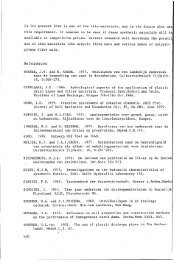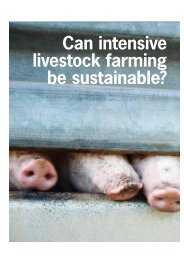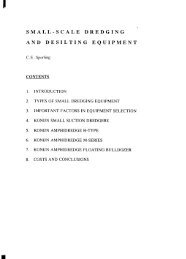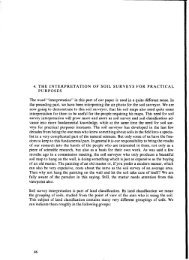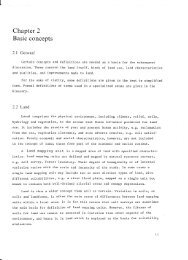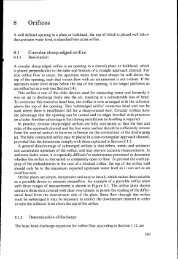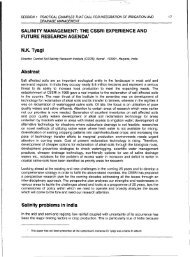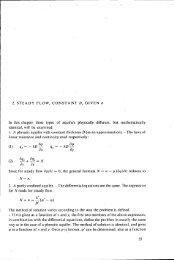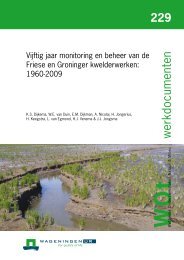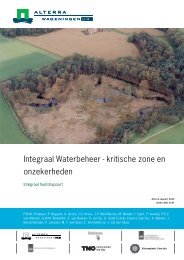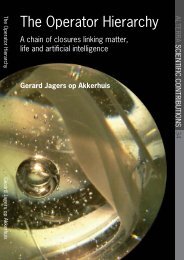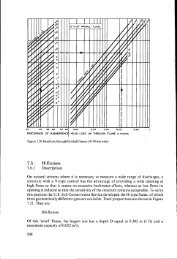Environmental aspects of acid sulphate soils - ROOT of content
Environmental aspects of acid sulphate soils - ROOT of content
Environmental aspects of acid sulphate soils - ROOT of content
Create successful ePaper yourself
Turn your PDF publications into a flip-book with our unique Google optimized e-Paper software.
Seasonally recurrent fish mortalities andulcerative disease outbreaks associated with<strong>acid</strong> <strong>sulphate</strong> <strong>soils</strong> in Australian estuariesR.B. Callinan', G.C. Fraser' and M.D. Melville2NSW Fisheries, Regional Veterinary Laboratory, Wollongbar AustraliaSchool <strong>of</strong> Geography, University <strong>of</strong> NSW, Kensington, AustraliaAbstractAcid <strong>sulphate</strong> and potential <strong>acid</strong> <strong>sulphate</strong> <strong>soils</strong> are now known to be widespread onthe coasts <strong>of</strong> Australia, particularly in northern and eastern areas. The onset <strong>of</strong> heavyrain in these areas causes a 'first-flush' run<strong>of</strong>f and drainage <strong>of</strong> phytotoxic water withproperties including low pH and high concentrations <strong>of</strong> dissolved aluminum. Thesewaters have caused massive fish kills. Recently, a new ulcerative fish disease, epizooticulcerative syndrome (EUS), has shown a pattern <strong>of</strong> seasonal recurrence in EasternAustralia also relating to these onset rains. However, the pattern <strong>of</strong> this disease'sspread through Australia and Southeast Asia strongly suggests involvement <strong>of</strong> an exoticinfectious agent. The oomycete'fungus, Aphanomyces sp. has been consistently isolatedfrom ulcers but it is unable to invade the intact skin <strong>of</strong> healthy fish. Early indicationssuggest that chemical properties associated with water draining from <strong>acid</strong><strong>sulphate</strong> soil areas cause sublethal skin damage that can allow fungal invasion. Thereis a clear spatial and temporal association between onset rains, drainage from <strong>acid</strong><strong>sulphate</strong> soil areas and outbreaks <strong>of</strong> EUS, although the details <strong>of</strong> the disease processhave yet to be established.This disease threatens a major protein resource for human consumption in the Asia-Pacific region, where population growth pressure and need for economic developmentare great.Our ongoing research intends to establish, through field and laboratory studies,the role <strong>of</strong> water quality and hydrological parameters in the pathogenesis <strong>of</strong> EUS.This will allow better management <strong>of</strong> <strong>acid</strong> <strong>sulphate</strong> soil areas, thereby enhancing sustainability<strong>of</strong> estuarine fisheries.IntroductionAcid <strong>sulphate</strong> <strong>soils</strong> and potential <strong>acid</strong> <strong>sulphate</strong> <strong>soils</strong> are widely distributed in tidalriver flood plains in eastern and northern Australia. The sulphidic layers in these <strong>soils</strong><strong>acid</strong>ify periodically under natural conditions, as in prolonged periods <strong>of</strong> dry weather,or following changes to flood plain hydrology, when backswamps and freshwaterlagoons are drainend by natural processes or human intervention.Recent studies in Australia have demonstrated probable causal relationships betweenmajor rain events, the presence <strong>of</strong> significant areas <strong>of</strong> <strong>acid</strong> <strong>sulphate</strong> soil in riverfloodplains and certain seasonally recurrent fish mortalities. Studies <strong>of</strong> epizootic ulcerativesydrome (EUS), a new disease <strong>of</strong> freshwater and estuarine fish in Australia, have403



